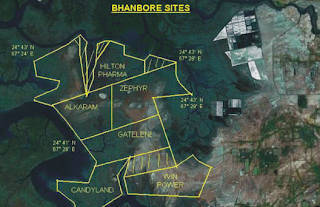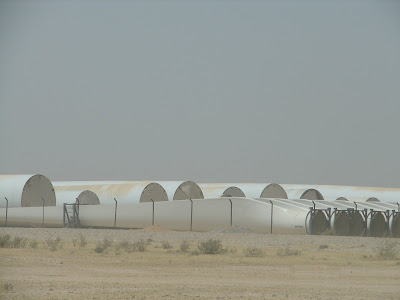The wind energy dream seems to be fading, mainly because of the government's flawed policies
Naveed Ahmad
http://jang.com.pk/thenews/nov2008-weekly/nos-09-11-2008/pol1.htm#5
Pakistan's current energy crisis, coupled with a drastic reduction in the Chenab river's water after the commissioning of Baglihar Dam, has become the nation's worst nightmare. The country's dependence on oil and gas to meet its primary energy needs amounts to an astounding 83.8 percent, while the share of hydro, coal and nuclear energy is merely 11 percent, 4.6 percent and 0.2 percent, respectively. Pakistan's maximum capacity of power generation stands at 17,793 megawatts, but only on paper. This is due to a variety of operational reasons, ranging from technical faults in grids to the lack of water storage in reservoirs.
Karachi, the country's financial capital, witnessed the worst power outages this summer, bringing the commercial activity to a near standstill. Despite purchasing energy at a high cost, the existing gap between demand and supply in the city for any given day, especially in the summers, has proven impossible to bridge. The situation may easy a bit during winter, but there were no definitive answers with the Karachi Electric Supply Corporation (KESC) when The News on Sunday made inquires in this regard.
Karachi's population is projected to reach 20 million by 2015 from the existing 14 million, with power consumption expected to double. Exactly in the same year, the Karachi Nuclear Power Plant (KANUPP) will retire, according to the Planning Commission of Pakistan. Though the gradual switching over to the expensive nuclear power generation has met with some success on Chashma III and Chashma IV fronts with the Chinese technical support, the solution comes at a slow pace and high political costs.
For environmental and commercial reasons, the answer lies in the solar and wind energy, potential for both of which has exceeded Pakistan's expectations. The solar energy solution will become commercially viable the day it defeats the rich oil lobby. The state of California in the United States has been spearheading the drive to take the less-treaded paths of solar energy solutions, but the success faces bureaucratic hindrances rather than technical ones.
With Germany taking the lead, the entire Europe and many states in the United States and Canada have successfully harnessed clean and cheap wind energy. India has also been following suit with considerable success, knowing fully well the growing demand and increasing limitations of relying on power generation technologies dependent on water and petroleum. Malaysia and Indonesia have also realised this potential, given their vast coastal areas.
Scientifically speaking, global winds are caused by pressure differential across the earth's surface; the amount of solar radiation absorbed at the earth's surface is greater at the equator than at the poles, and the variation in the incoming heat sets up convective cells in the lowest layer of the atmosphere. On a smaller scale, wind is created because of temperature difference between land and seas and mountains and valleys. The local topographical features and roughness of the terrain also cause air movements.
Realising the tremendous potential of harnessing wind energy, especially in the wind corridor near Gharo along Sindh's coast belt, a detailed Wind Power Potential Survey of Coastal Areas of Pakistan was conducted by the Pakistan Meteorological Department in 2007. It estimates that the wind corridor in Sindh covers an area of about 9,700 square kilometres and the gross wind power potential of the region alone amounts to 43,000 megawatts. "Keeping in view the area utilisation constraints, the exploitable electric power generation potential of the area is estimated to be about 11,000 megawatts," the survey, however, adds.
During the three-year survey period, wind data was collected at 20 sites along Sindh's coastal belt. One minute speed and direction, five-minute average temperature, and 10-minute minimum and maximum wind speeds at 10-metre and 30-metre heights were recorded for this purpose. At 50-metre height, annual average wind speeds of 8.5, 7.0, 7.0, 6.7 and 6.6 metres per second were recorded at Jamshoro, Keti Bandar, Nooriabad, Thatta and Gharo, respectively. Annual wind power densities at Jamshoro, Nooriabad, Talhar, Keti Bandar, Thatta, Thana Bulakhan, Hyderabad and Gharo were recorded at 770, 454, 445, 374, 373, 371 and 350 watts per square metre, respectively.
According to international wind classification, this power density puts Jamshoro, Nooriabad, Talhar and Keti Bandar in the category of excellent sites and Thatta, Thana Bulakhan, Hyderabad and Gharo in the category of good sites for wind power generation. Monthly and annual values of wind-generated electric power have also been computed on a hypothetical 600 kilowatt wind turbine, the annual power production of which comes to 2.1 million kilowatt-hours (kWh) for Jamshoro, 1.5 million kWh for Keti Bandar, 1.5 million kWh for Nooriabad, 1.4 million kWh for Gharo and 1.3 million kWh for Thatta. Internationally, any site with a capacity of 25 percent is considered to be suitable for the installation of economically-viable commercial wind farms.
The government estimates that more than 5,000 villages can be electrified through wind energy in Sindh, Balochistan and the Northern Areas. Moreover, enormous wind energy potential exists in coastal areas of Balochistan, as well as desert areas of the Punjab and Sindh. Various international donors, such as USAID, GTZ and the UNDP, are eager to assist Pakistan in assessing and exploiting the same.
However, the meager efforts of the Alternate Energy Development Board (AEDB) aimed at harnessing wind energy are set to be reversed with the PPP-led coalition government mulling to cancel 93 letters of intent (LOIs) issued to national and multinational companies for setting up wind energy projects. Many investors had even got land allotted for installing wind energy farms, but delay on the part of the National Electric Power Regulatory Authority (NEPRA) in deciding the tariff has been a major hurdle in the takeoff of these projects. With increasing tariffs and mounting installation costs, the interest of investors is waning, say senior officials in the Ministry of Water and Power.
It has been learned that the LOIs are set to be cancelled on the pretext of investors failing to meet the conditions and validity period in achieving the milestones associated with their LOI. The AEDB denies any likelihood of cancelling the LoIs and claims that the country's first-ever wind IPP will start power production before the end of the year. However, experts like Major (r) Asif Masood believe that the projects are less likely to materliase with an affordable tariff agreed with NEPRA. He explains that the private power producers as well as the government sector's power production cost varies between 3.5 cents per kWh and 6.2 cents per kWh.
The investors, on the other hand, complain of the lack of political will and red-tappism on the government's part. "The LoIs are being cancelled under political pressures in Sindh, so that the land spared for wind farms can be allotted the blued-eyed,î says one such licensee. The Ministry of Water and Power, as well as the AEDB, obviously refute these allegations.
Asif Masood says not only Pakistan is losing precious time with this delay, but also the cost of projects has mounted significantly. For example, he says, a 50-megawatt plan would have cost $110 million in 2004, but the same would now cost more than $160 million. "Also add to that the environmental and commercial price of expensive energy used till such clear initiatives materialise."
The AEDB, however, hopes that the first wind power project of Pakistan will be commissioned by the end of this year. Zorlu Enerji Pakistan Ltd, a local subsidiary of Zorlu Enerji of Turkey, pursuing the development a 50-megwatt wind power project, will complete and commission the first phase of the project (6 megawatts) in December 2008. Five turbines of 1.2-megawatt capacity each will be installed in this phase. All the equipment, including rotor blades, towers, generators, etc, has already arrived at the project's site. Moreover, in another development, the AEDB has signed a memorandum of understanding (MOU) with the Karachi Port Trust (KPT) for the development of a 50-megawatt wind power project at Hawks Bay, Karachi. As per the MOU, the KPT will develop the project and the AEDB will facilitate it in this process.
With the government's commitment in place and the LoIs intact, the hope for harnessing wind energy can offer a much needed relief to the people of Pakistan. However, more challenges await the government and the wind IPPs, because turbine and masts are in short supply in the international market owing to the growing dependence on cleaner energy sources. Germany is by far the leader in wind power technology, followed by the Netherlands, Denmark and other European countries. The international market for turbines is living with a delay of 14-16 months. As usual, Pakistan is left with the quick-fix solution of installing the Chinese-made windmills, which do not match the European standards of efficiency and durability.
Pakistan must not repeat the mistakes it made during conversion from petrol to natural gas, by not seeking transfer of technology from friendly nations and CNG market leaders, such as Italy. CNG kits and cylinders worth millions of dollars are imported every year in the age of weakening rupee against dollar. AEDB officials say talks are underway with international companies to start the manufacturing of micro-wind turbines and parts of large wind turbines. So far, about 30 wind mills for pumping water have been installed for experimental purposes in different parts of Sindh and Balochistan.
In addition to the development activities in the field of wind energy for on-grid electricity production, wind energy is also being used for the electrification of remote off-grid villages in the southern coastal areas of Pakistan. So far, more than 18 villages have been electrified using micro-wind turbines. Moreover, indigenous development of micro-wind turbines has also started in Pakistan. The last but not the least factor worth considering remains the lack of trained workforce for the installation and maintenance of wind turbines. With widening demand-supply gaps in the power sector and the need for trained manpower staring in the face, the government should enter into agreements with European nations as much for technology transfer as for the training of workforce.
The writer is a special correspondent of Geo News, Islamabad






This comment has been removed by the author.
ReplyDelete